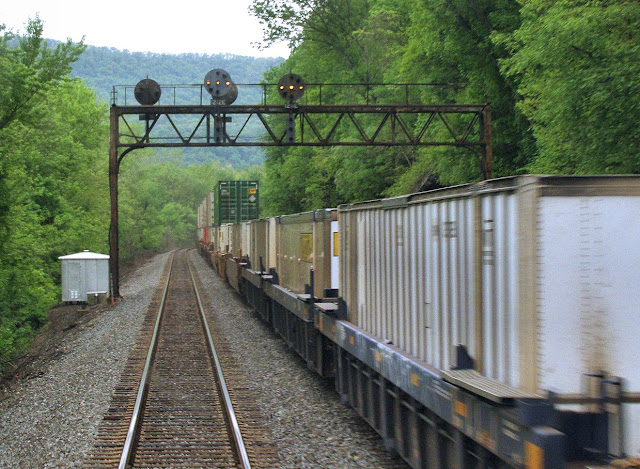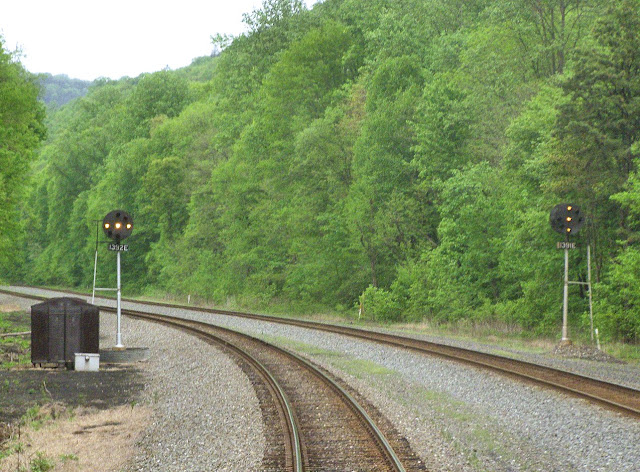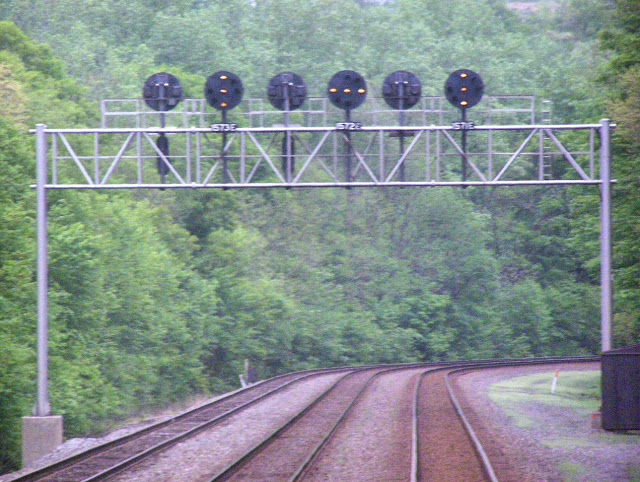If you are interested in viewing the entire set of photos for this part you may find them here.
We begin our journey as our train leaves Amtrak property at CP-HARRIS and you may follow along with this diagram. More detailed Conrail interlocking charts of the former Conrail Philadelphia division interlockings can be found here (25MB pdf)
Up until about 1990 CP-HARRIS was actually an Amtrak interlocking controlled by HARRIS tower (which is now a museum). This was a holdover from the time when freight trains running on the east side of the Susquehanna came up from the electrified main to the south through the Harrisburg station and then westward to Pittsburgh. After Conrail dumped electrified operations around 1981 it began to shift its New York terminal freight traffic to the Reading/Lehigh Valley route via Reading, PA. The route was not only faster it avoided having to deal with Amtrak notoriously high trackage rates.
As a result HARRIS interlocking was in a somewhat awkward position being operated by Amtrak and optimized for "PRR" route traffic. Around 1990 Conrail implemented a project to take over control of HARRIS and re-align the routings to better connect with the former Reading Lebanon Valley branch, now known as the Harrisburg Line, and also eliminate all of the redundant yard trackage formerly used for electric to diesel power changes. Here we can see the NS Harrisburg Line taking the straight route, while the single connecting track to the Amtrak station branches off to the right. The millage here picks up from from Amtrak and we are 105 miles from Suburban Station, Philadelphia.
The signals are small target searchlights that were originally popular on the New York Central subsidiary Michigan Central. These were briefly the standard signals on the Conrail system before the switch to round target colour lights. CP-HARRIS was re-signaled in the window between when PRR Position Lights stopped being installed and colour lights came into vogue. Here we see an old overhead catenary support being jury rigged into a signal gantry supporting three, three headed searchlights. The slow speed (15mph) bottom head is used for the Amtrak connection. This is currently used by only 2 trains per day as the Chicago through train on this route was eliminated in 2005.
Our first block signal is the MP 107 automatic mid way between CP-HARRIS and CP-ROCKVILLE so it is distant to both. When Conrail re-signaled in the late 1980's it modified the PRR numbering procedure. Signals were no longer uniformly numbered on all tracks to the nearest 10th of a mile, even eastbound and odd westbound. Instead the signals were numbered to the whole mile and suffixed with the track number and direction. So the 1071E signal is Mp 107, #1 track, east direction.
Both these signals have lower heads with both | and / indications in both directions as CP-HARRIS and CP-ROCKVILLE have slow speed moves that require Approach Slow ( / over / ). Signal 1072E/W is Safetran equipment and looks newer than 1071E/W, although I don't have any further information about this. Note the MP 107 Harrisburg Dragging Equipment Detector is located immediately west of the signals. This is cab signaled territory, but wayside signals are in place throughout.
We next arrive at CP-ROCKVILLE. This was completely re-constructed in the 80's re-signaling project and as a result received a brand new, 4-track position light gantry for westbound movements. BTW I visited CP-ROCKVILLE once on the ground so if you are interested click and scroll down.
CP-ROCKVILLE is a Y junction between the Buffalo Line (left track) and the Pittsburgh Line (right tracks). The used to be a very large 1890'sstyle interlocking that survived until 1986 when it was demolished. The interlocking plant was rebuilt in 1942 with a 43-lever US&S Model 14 machine replacing the original electro-mechanical lever frame.
The junction spills out onto the famous Rockville Bridge. All of the points were pneumatic, but were replaced with electric between 2003 and 2005.
The interlocking had to be slightly rebuilt again in the early 2000's when high winds pushed an intermodal container on the 3rd track into the Susquehanna River below. NS decided to prevent this sort of incident from happening again and removed the third track from the bridge and its switch from CP-ROCKVILLE and re-connected it at an expanded CP-MARY on the other side of the bridge.
This necessitated the removal of a tubular 3-track Position Light cantilever mast on the west end of the interlocking. However NS decided to be super cool and replaced it with two BRAND NEW PL masts!!
Of course they were of Safetran manufacture.
There is the base of the old 3-track Cantilever mast.
Next is CP-BANKS where the Pittsburgh Line joins the Enola Branch I mentioned in my post on STELL interlocking. The Enola Branch uses the two center tracks, while the Pittsburgh Line the outer tracks. The flyovers are located back at the west end of the Rockville Bridge. Here we can see the impressively wide eastbound PRR signal gantry.
CP-BANKS has an interlocked talking High Car Detector due to the close clearances on some Enola Branch tracks. Because of having to re-certify modifications due to being interlocked the detector still reads out as "Conrail, CP-BANKS, Marysville Pennsylvania" instead of the much more sterile "NS Detector Milepost 113 point 2". The 1980's plant is not much different than the 1912 built interlocking it replaced.
Coming out the other side of CP-BANKS are the two main tracks and a controlled siding. The eastbound gantry even looks like it has been painted within the last 20 years or so. The position lights are mounted on gantry masts due to some requirement of extra height. Also on the rightmost siding signal it appears that Conrail was not immune from installing improperly round lower heads. Another note on that siding signal is how the upper head has a / indication despite only having medium speed routes available to it. This is an old Penn Central practice that was a reaction to PRR signals being unable to display combination aspects such as Medium Approach Medium. The PRR simply used exit signals to provide the proper information in situations of back to back diverging moves, but the PR implemented a special instruction that allowed trains to diverge over an Approach Medium as long as the last signal was not Clear. So instead of the Approach Medium->Medium Clear->Approach Medium->Medium Clear progression trains could get Approach Medium->Approach Medium->Medium Clear.
Automatic 116 was once a popular railfan destination as it had a 3-track PRR PL gantry in the classic style with all signals having the lower distant |. Unfortunately in accordance of its recent Killjoy policy NS decided to replace this gantry with a new one supporting the dreaded darth vader signals.
The 4-mile long siding ends at CP-CANNON. The westbound home signal is in the classic style, but is definitely in need of some paint.
CP-CANNON replaced the previous VIEW interlocking at the same location. it is a basic crossover and end of the siding. CP-BANKS does not have a full crossover so this is the critical to some movements. Points were converted to electric in the 1980 rebuild.
Eastbound mast signals next to the interlocking hut. A train has recently passed us, but another behind it required the signal to be fleeted and is displaying a Restricting aspect.
To continue following along switch to this diagram. Again interlocking charts of the Pittsburgh Division interlockings c 1998can be found here (30MB pdf).
Automatic 121 on a classic PRR gantry along with that following train.
Automatic 124 are another example of the bi-directional position light block signals installed new in the late 1980's. Signal is at Stop and Proceed due to a third eastbound train.
Automatic 126. Like on Amtrak block lengths are on the order of 2 miles.
Automatic 128 are a pair of simple target type color lights installed by Conrail in the 1990s to replace a PRR signal gantry with structural problems.
Automatic 131. Position light masts and w/b distant to CP-PORT.
CP-PORT is a basic crossover and an interlocked connection to an industrial track. Here are the w/b PL signals on a classic gantry.
The switches were recently replaced by NS, but the pneumatic point machines were retained. :-)
Westbound PL gantry was replaced by color lights in the 90's and the track 1 target color light was recently replaced again by an NS style darth vader for reasons unknown.
Automatic 135. Position light mast on #2 track, darth vader mast on #1 track. The darth vader replaced an earlier target color light signal for unknown reasons.
Automatic 137.
Automatic 139 and closeup of 1392E. All of the relay cases installed in the 80's rebuild were made of non-destructively rusting Corten steel. You can see again how brilliant properly focused US&S PL-3 units are.
Automatic 142, distant to CP-THOMPSON.

Most crossovers on the rebuilt PRR Main Line were good for Limited Speed.
Eastbound PL masts have been placed in the beds of the former tracks. Short sighted?
Automatic 146, classic PRR gantry and distant to CP-THOMPSON.
Automatic 148, another replaced PRR PL gantry. The cost of the 80's CTC project prompted Conrail to reuse as much hardware as possible. Yes, that is a set of HBD-DED sensors in the foreground.
Automatic signals 151 at Port Royal are a popular railfan location due to the overhead road bridge. Note the interesting double mast placement on the 2 track signals. Visibility may have been an issue, but the line does have cab signaling. These are distant to CP-MIFFLIN.
Westbound PL mast signals at CP-MIFFLIN as well as the pneumatic A-5 machine on the 7B switch. The signals have been recently painted. PRR practice was to paint the entire signal black, a system which is still used by Amtrak. The Penn Central and Conrail added a silver base. When signal structures became aluminum Conrail painted just the structure behind the signal heads black and left the rest unpainted. Today the major freight railroads no longer apply any paint to their signal structures.
7 switch at CP-MIFFLIN. Note the shininess indicates a high amount of crossing-over here.
CP-MIFFLIN is the south end of a controlled siding as well as a connection to an industrial / MofW track. Here we see the start of the siding and the MofW connector.
The 3-track classic PRR gantry was replaced in 2007 due to rust issues by a 3-track darth vader cantilever. Note the siding track can receive the Approach Medium diverge due to a short block length to the 151 automatic.
This forest of mast signals at the 155 automatics probably dates from the Penn Central re-signaling when signals were still placed to the right hand side of the tracks for the engineer driving long hood locomotives. The 1551W signal was possibly added new as that track would have still been single direction eastbound in the old 3-track system. Traffic on the siding is set eastbound as seen on the 1553E signal being Approach.
Wow, this is cool. A 3-track tubular position light gantry installed in the 1980's CTC project for the 157 automatic. This is distant to CP-HAWSTONE and uses Safetran Equipment.
CP-HAWSTONE is a trailing point ladder for the end of the 6-mile long controlled siding. Here is the classic PRR 3-track PL gantry.
Eastbound masts at CP-HARSTONE. Track 1 is cleared for an approaching freight train. I should mention that while the position lights here are not fully colorized as they are on Amtrak, red lenses were added to the upper head at absolute signals to enhanced recognizability of absolute Stop signals by the Penn Central and later Conrail.
Automatic signals 162 are double distants for CP-HAWSTONE to the east and CP-LEWIS to the west. These are 90's replacement colour lights for a failed PRR gantry.
The station atop at Lewistown, PA is within the interlocking limits of CP-LEWIS. Here a TOFC train rumbles through blocking my full view of the interlocking.
The 4W signal has been recently painted just like the masts at CP-MIFFLIN. This is a nice closeup shot of how the position light cells are structured in a US&S PL signal.
The 4AE signal mast at CP-LEWIS is next to the interlocking hut. Some Conrail intelrocking placards contained both the name and milepost of the interlocking in reflective blue and white. Note the station building has been restored and painted.
CP-LEWIS contains an interlocked yard lead with dwarf and pedestal position light signals.
Automatic signal 167 are the double distants for CP-LEWIS and CP-LONG. The third track is actually a yard/industrial track and is not signaled.
Westbound position light mast signals at CP-LONG. CP-LONG is not only the termination of the yard track, but also a complete crossover. This allows passenger trains to easily platform at the single platform on #2 track then cross immediately back to #1 track. Of course the train can use the duckboards to discharge directly on track 1.
Eastbound masts at CP-LONG. whomever installed these masts seems to lack a functioning level.
Anyway, that's it for part 5. Comment and stay tuned for part 6!.























































No comments:
Post a Comment